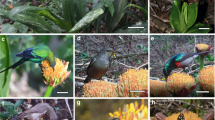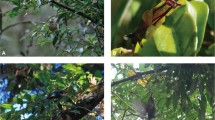Abstract
Charles Darwin correctly predicted the existence of an extraordinarily long-tongued hawkmoth in Madagascar, based on the length of the floral spur of an Angraecum orchid. This hawkmoth, Xanthopan morganii, is also the longest-tongued hawkmoth on the African mainland, but its ecological role as a pollinator has been virtually unknown outside of Madagascar. We investigated whether X. morganii pollinates Bonatea steudneri, an orchid with floral spurs that vary from 10 to 21 cm in length among populations. At a forest locality in central Kenya, we observed X. morganii individuals with tongues ca. 16 cm in length pollinating B. steudneri plants with spurs ca. 15 cm in length. At other localities in Kenya, we observed visits by the hawkmoths Agrius convolvuli (tongue c. 12 cm) and Coelonia fulvinotata (tongue ca. 10 cm). Pollinaria of B. steudneri are attached to the eyes of hawkmoth visitors. Flowers of B. steudneri show several adaptations for hawkmoth pollination, including anthesis at dusk and nocturnal emission of scent dominated by the volatile compound linalool. This study highlights the potential for predicting certain highly specialized interactions among species by matching of their respective morphological dimensions.





Similar content being viewed by others
References
Agnew ADQ, Agnew S (1994) Upland Kenya wild flowers: a flora of the ferns and herbaceous flowering plants of Upland Kenya. Oxford University Press, London
Alexandersson R, Johnson SD (2002) Pollinator mediated selection on flower-tube length in a hawkmoth-pollinated Gladiolus (Iridaceae). Proc Roy Soc London B 269:631–636. https://doi.org/10.1098/rspb.2001.1928
Amorim FW, Wyatt GE, Sazima M (2014) Low abundance of long-tongued pollinators leads to pollen limitation in four specialized hawkmoth-pollinated plants in the Atlantic Rain forest, Brazil. Naturwissenschaften 101:893–905. https://doi.org/10.1007/s00114-014-1230-y
Balducci MG, Van der Niet T, Johnson SD (2019) Butterfly pollination of Bonatea cassidea (Orchidaceae): solving a puzzle from the Darwin era. S African J Bot 123:308–316. https://doi.org/10.1016/j.sajb.2019.03.030
Baum DA (1995) The comparative pollination and floral biology of baobabs (Adansonia-Bombacaceae). Ann Missouri Bot Gard 82:322–348. https://doi.org/10.2307/2399883
Brantjes N (1978) Sensory responses to flowers in night-flying moths. In: Richards AJ (ed) The pollination of flowers by insects. Academic Press, London, pp 13–19
Braun M, Dötterl S, Schlindwein C, Gottsberger G (2012) Can nectar be a disadvantage? Contrasting pollination natural histories of two woody Violaceae from the Neotropics. Int J Pl Sci 173:161–171. https://doi.org/10.1086/663167
Clarke KR, Gorley RN (2006) PRIMER v6: user manual/tutorial. Primer-E Ltd, Plymouth
Darwin CR (1862) On the various contrivances by which british and foreign orchids are fertilized by insects. John Murray, London
Dobson HE (2006) Relationship between floral fragrance composition and type of pollinator. In: Dudareva N, Pichersky E (eds) Biology of floral scent. Taylor and Francis, Boca Raton, pp 147–198
Hammer Ø, Harper DAT, Ryan PD (2001) PAST: paleonotological statistics software package for education and analysis. Palaeontol Electronica 4:1–9
Johnson SD (1995) Observations of hawkmoth pollination in the South African orchid Disa cooperi. Nordic J Bot 15:121–125. https://doi.org/10.1093/aob/mcx203
Johnson SD, Edwards TJ (2000) The structure and function of orchid pollinaria. Pl Syst Evol 222:243–269. https://doi.org/10.1007/bf00984105
Johnson SD, Liltved W (1997) Hawkmoth pollination of Bonatea speciosa (Orchidaceae) in a South African coastal forest. Nordic J Botany 17:5–10. https://doi.org/10.1111/j.1756-1051.1997.tb00286.x
Johnson SD, Raguso R (2016) The long-tongued hawkmoth pollinator niche for native and invasive plants in Africa. Ann Bot (Oxford) 117:25–36. https://doi.org/10.1093/aob/mcv137
Johnson SD, Steiner KE (1997) Long-tongued fly pollination and evolution of floral spur length in the Disa draconis complex (Orchidaceae). Evolution 51:45–53. https://doi.org/10.1111/j.1558-5646.1997.tb02387.x
Johnson SD, Neal PR, Harder LD (2005) Pollen fates and the limits on male reproductive success in an orchid population. Biol J Linn Soc 86:175–190. https://doi.org/10.1111/j.1095-8312.2005.00541.x
Johnson SD, Moré M, Amorim FW, Haber WA, Frankie GW, Stanley DA, Coccuci AA, Raguso R (2017) The long and the short of it: a global analysis of hawkmoth pollination niches and interaction networks. Funct Ecol 31:101–115
Jürgens A, Witt T, Gottsberger G (2002) Flower scent composition in night-flowering Silene species (Caryophyllaceae). Biochem Syst Ecol 30:383–397. https://doi.org/10.1016/S0305-1978(01)00106-5
Knudsen JT, Tollsten L (1993) Trends in floral scent chemistry in pollination syndromes: floral scent composition in moth-pollinated taxa. Bot J Linn Soc 113:263–284. https://doi.org/10.1111/j.1095-8339.1993.tb00340.x
la Croix IF, Cribb PJ (1995) 163. Orchidaceae. In: Pope GV (ed) Flora Zambesiaca, vol 11, part 1. Flora Zambesiaca Managing Committee, London. Royal Botanical Gardens, Kew, London, pp 1–320
la Croix IF, la Croix E (1997) African orchids in the wild and in cultivation. Timber Press, Portland
Luyt R, Johnson SD (2001) Hawkmoth pollination of the African epiphytic orchid Mystacidium venosum, with special reference to flower and pollen longevity. Pl Syst Evol 228:49–62. https://doi.org/10.1007/s006060170036
Martins DJ, Johnson SD (2007) Hawkmoth pollination of aerangoid orchids in Kenya, with special reference to nectar sugar concentration gradients in the floral spurs. Amer J Bot 94:650–659. https://doi.org/10.3732/ajb.94.4.650
Martins DJ, Johnson SD (2013) Interactions between hawkmoths and flowering plants in East Africa: polyphagy and evolutionary specialization in an ecological context. Biol J Linn Soc 110:199–213. https://doi.org/10.1111/bij.12107
Micheneau C, Johnson SD, Fay MF (2009) Orchid pollination: from Darwin to the present day. Bot J Linn Soc 161:1–19. https://doi.org/10.1111/j.1095-8339.2009.00995.x
Muchhala N, Thomson JD (2009) Going to great lengths: selection for long corolla tubes in an extremely specialized bat-flower mutualism. Proc Roy Soc Biol Ser B 276:2147–2152. https://doi.org/10.1098/rspb.2009.0102
Nicolson SW, Nepi M, Pacini E (2007) Nectaries and nectar. Springer, Doordrecht
Nilsson LA (1978) Pollination ecology and adaptation in Platanthera chlorantha (Orchidaceae). Bot Not 131:35–51
Nilsson LA (1988) The evolution of flowers with deep corolla tubes. Nature 334:147–149. https://doi.org/10.1038/334147a0
Nilsson LA (1998) Deep flowers for long tongues. Trends Ecol Evol 13:259–260. https://doi.org/10.1016/s0169-5347(98)01359-7
Pauw A, Stofberg J, Waterman RJ (2009) Flies and flowers in Darwin’s race. Evolution 63:268–279
Pedron M, Buzatto CR, Singer RB, Batista JA, Moser A (2012) Pollination biology of four sympatric species of Habenaria (Orchidaceae: Orchidinae) from southern Brazil. Bot J Linn Soc 170:141–156. https://doi.org/10.1111/j.1095-8339.2012.01285.x
Peter CI, Coombs G, Huchzermeyer C, Venter N, Winkler A, Hutton D, Papier L, Dold A, Johnson SD (2009) Confirmation of hawkmoth pollination in Habenaria epipactidea: leg placement of pollinaria and crepuscular scent emission. S African J Bot 75:744–750. https://doi.org/10.1016/j.sajb.2009.08.007
Pinhey EC (1962) Hawkmoths of central and southern Africa. Longmans, Cape Town
Plepys D, Ibarra F, Löfstedt C (2002) Volatiles from flowers of Platanthera bifolia (Orchidaceae) attractive to the silver Y moth, Autographa gamma (Lepidoptera: Noctuidae). Oikos 99:69–74. https://doi.org/10.1034/j.1600-0706.2002.990107.x
Ponsie M, Edwards TJ, Johnson SD (2007) A taxonomic revision of Bonatea Willd. (Orchidaceae: Orchidoideae: Habenariinae). S African J Bot 73:1–21. https://doi.org/10.1016/j.sajb.2006.05.003
R Core Development Team (2016) R: a language and environment for statistical computing. R Foundation for Statistical Computing, Vienna. Available at: http://www.R-project.org/
Raguso RA, Pichersky E (1999) New perspectives in pollination biology: floral fragrances. A day in the life of a linalool molecule: chemical communication in a plant-pollinator system. Part 1: linalool biosynthesis in flowering plants. Pl Spec Biol 14:95–120
Raguso RA, Light DM, Pickersky E (1996) Electroantennogram responses of Hyles lineata (Sphingidae: Lepidoptera) to volatile compounds from Clarkia breweri (Onagraceae) and other moth-pollinated flowers. J Chem Ecol 22:1735–1766. https://doi.org/10.1007/bf02028502
Shuttleworth A, Johnson SD (2009) The importance of scent and nectar filters in a specialized wasp-pollination system. Funct Ecol 23:931–940. https://doi.org/10.1111/j.1365-2435.2009.01573.x
Stewart J (1996) Orchids of Kenya. Timber Press, Portland
Van der Niet T, Jürgens A, Johnson SD (2010) Pollinators, floral morphology and scent chemistry in the southern African orchid genus Schizochilus. S African J Bot 76:726–738. https://doi.org/10.1016/j.sajb.2010.07.004
Wasserthal LT (1997) The pollinators of the Malagasy star orchids Angraecum sesquipedale, A. sororium and A. compactum and the evolution of extremely long spurs by pollinator shift. Bot Acta Neerl 110:343–359. https://doi.org/10.1111/j.1438-8677.1997.tb00650.x
Williamson G (1977) Orchids of South Central Africa. J.M. Dent and Sons Ltd., London
Acknowledgements
We would like to thank Benny Bytebier and Daniel Odhiambo for logistical support and locating the orchid populations. Research was supported by the National Research Foundation of South Africa (MGB and SDJ). We would like to thank Ruth Cozien for help with analysis of nectar sugar composition in the laboratory. We also thank Ian Kitching for confirming the identity of Xanthopan morganii. Martins’ work on pollination in Kenya is supported by the Mpala Research Centre, Princeton University, National Geographic Society, Kenya Orchid Society and Whitley Fund for Nature. We thank the East Africa Herbarium and National Museums of Kenya for access to their collections.
Author information
Authors and Affiliations
Corresponding author
Additional information
Handling Editor: Livia Wanntorp.
Publisher's Note
Springer Nature remains neutral with regard to jurisdictional claims in published maps and institutional affiliations.
Electronic supplementary material
Below is the link to the electronic supplementary material.
Information on Electronic Supplementary Material
Information on Electronic Supplementary Material
Online Resource 1. Bonatea steudneri spur length measurements and locality information from available herbarium specimens.
Online Resource 2. The relationship between nectar volume (µL) and nectar column height (cm) in flowers of Bonatea steudneri.
Online Resource 3. Non-metric multidimensional scaling (NMDS) based on the Bray–Curtis similarity matrices of Bonatea steudneri floral scent profile sampled at midday and at 19:00 h.
Rights and permissions
About this article
Cite this article
Balducci, M.G., Martins, D.J. & Johnson, S.D. Pollination of the long-spurred African terrestrial orchid Bonatea steudneri by long-tongued hawkmoths, notably Xanthopan morganii. Plant Syst Evol 305, 765–775 (2019). https://doi.org/10.1007/s00606-019-01605-2
Received:
Accepted:
Published:
Issue Date:
DOI: https://doi.org/10.1007/s00606-019-01605-2




